2021 VOLKSWAGEN TIGUAN change wheel
[x] Cancel search: change wheelPage 148 of 341
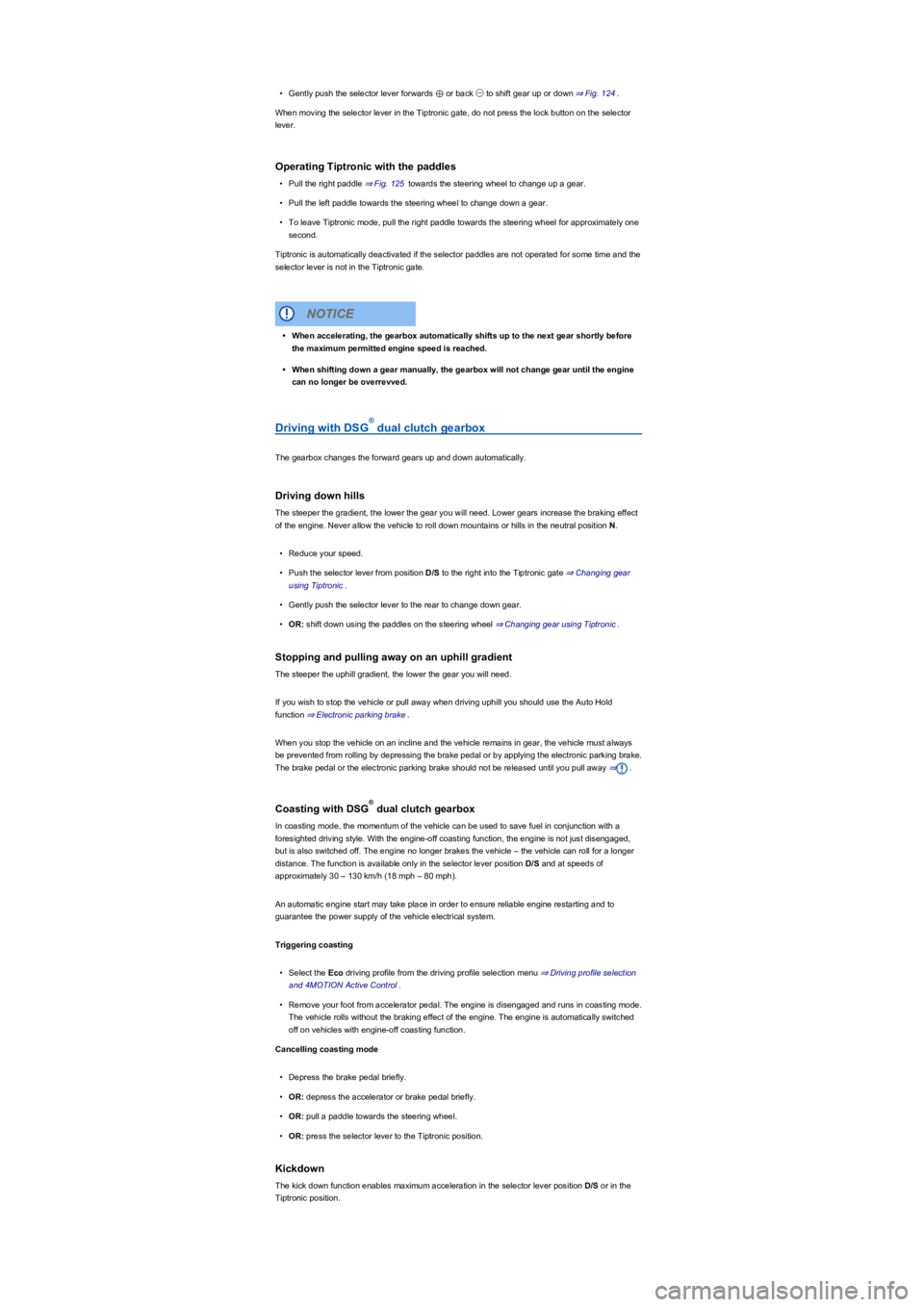
•Gently push the selector lever forwards ⊕ or back ㊀ to shift gear up or down ⇒ Fig. 124.
When moving the selector lever in the Tiptronic gate, do not press the lock button on the selector
lever.
Operating Tiptronic with the paddles
•Pull the right paddle ⇒ Fig. 125 towards the steering wheel to change up a gear.
•Pull the left paddle towards the steering wheel to change down a gear.
•To leave Tiptronic mode, pull the right paddle towards the steering wheel for approximately one
second.
Tiptronic is automatically deactivated if the selector paddles are not operated for some time and the
selector lever is not in the Tiptronic gate.
Driving with DSG dual clutch gearbox
The gearbox changes the forward gears up and down automatically.
Driving down hills
The steeper the gradient, the lower the gear you will need. Lower gears increase the braking effect
of the engine. Never allow the vehicle to roll down mountains or hills in the neutral position N.
•Reduce your speed.
•Push the selector lever from position D/S to the right into the Tiptronic gate ⇒ Changing gear
using Tiptronic.
•Gently push the selector lever to the rear to change down gear.
•OR: shift down using the paddles on the steering wheel ⇒ Changing gear using Tiptronic.
Stopping and pulling away on an uphill gradient
The steeper the uphill gradient, the lower the gear you will need.
If you wish to stop the vehicle or pull away when driving uphill you should use the Auto Hold
function ⇒ Electronic parking brake.
When you stop the vehicle on an incline and the vehicle remains in gear, the vehicle must always
be prevented from rolling by depressing the brake pedal or by applying the electronic parking brake.
The brake pedal or the electronic parking brake should not be released until you pull away ⇒.
Coasting with DSG dual clutch gearbox
In coasting mode, the momentum of the vehicle can be used to save fuel in conjunction with a
foresighted driving style. With the engine-off coasting function, the engine is not just disengaged,
but is also switched off. The engine no longer brakes the vehicle – the vehicle can roll for a longer
distance. The function is available only in the selector lever position D/S and at speeds of
approximately 30 – 130 km/h (18 mph – 80 mphyf�.
An automatic engine start may take place in order to ensure reliable engine restarting and to
guarantee the power supply of the vehicle electrical system.
Triggering coasting
•Select the Eco driving profile from the driving profile selection menu ⇒ Driving profile selection
and 4MOTION Active Control.
•Remove your foot from accelerator pedal. The engine is disengaged and runs in coasting mode.
The vehicle rolls without the braking effect of the engine. The engine is automatically switched
off on vehicles with engine-off coasting function.
Cancelling coasting mode
•Depress the brake pedal briefly.
•OR: depress the accelerator or brake pedal briefly.
•OR: pull a paddle towards the steering wheel.
•OR: press the selector lever to the Tiptronic position.
Kickdown
The kick down function enables maximum acceleration in the selector lever position D/S or in the
Tiptronic position.
•When accelerating, the gearbox automatically shifts up to the next gear shortly before
the maximum permitted engine speed is reached.
•When shifting down a gear manually, the gearbox will not change gear until the engine
can no longer be overrevved.
NOTICE
®
®
Page 156 of 341
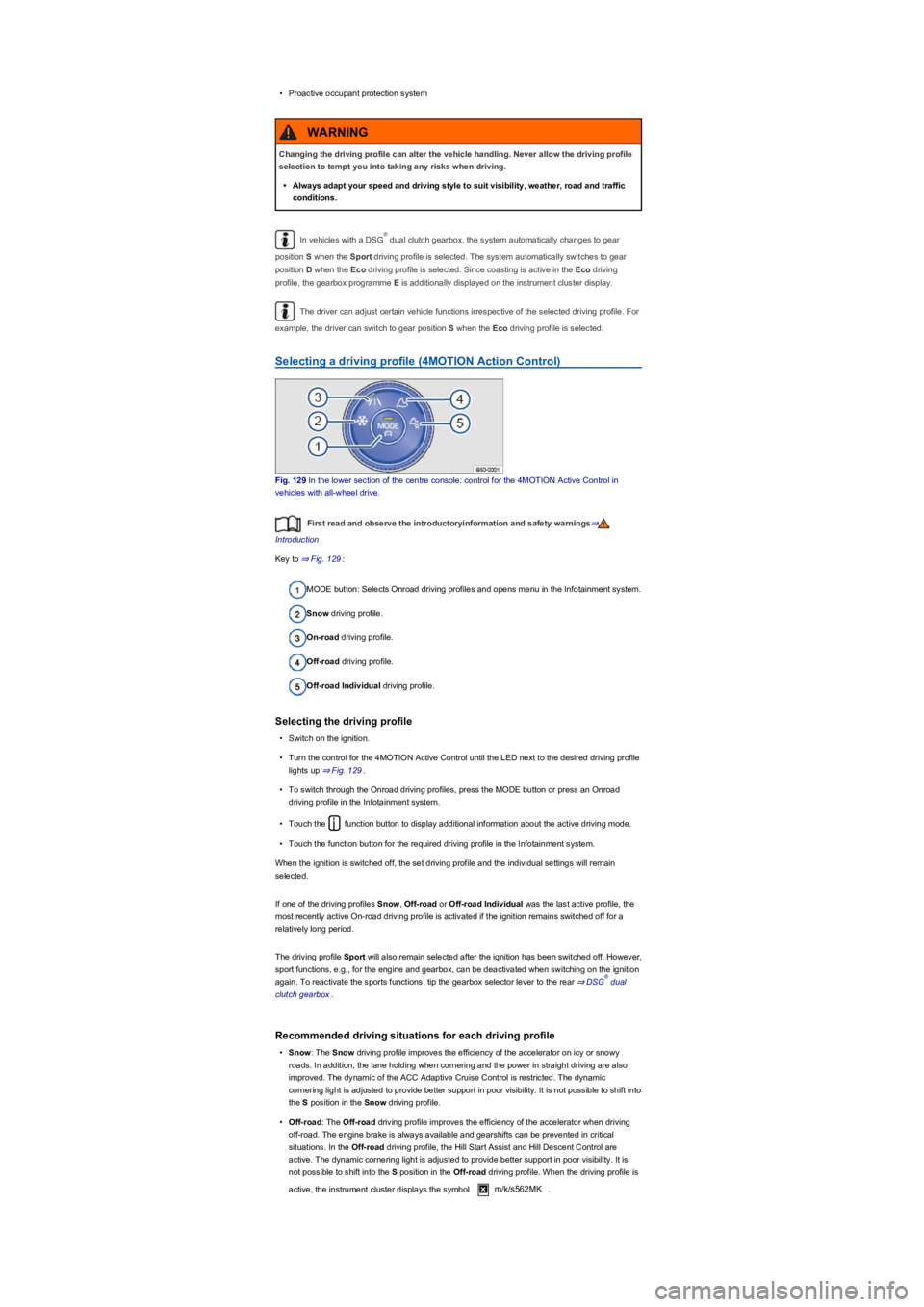
•Proactive occupant protection system
In vehicles with a DSG dual clutch gearbox, the system automatically changes to gear
position S when the Sport driving profile is selected. The system automatically switches to gear
position D when the Eco driving profile is selected. Since coasting is active in the Eco driving
profile, the gearbox programme E is additionally displayed on the instrument cluster display.
The driver can adjust certain vehicle functions irrespective of the selected driving profile. For
example, the driver can switch to gear position S when the Eco driving profile is selected.
Selecting a driving profile (4MOTION Action Controlyf
Fig. 129 In the lower section of the centre console: control for the 4MOTION Active Control in
vehicles with all-wheel drive.
First read and observe the introductoryinformation and safety warnings⇒
Introduction
Key to ⇒ Fig. 129:
MODE button: Selects Onroad driving profiles and opens menu in the Infotainment system.
Snow driving profile.
On-road driving profile.
Off-road driving profile.
Off-road Individual driving profile.
Selecting the driving profile
•Switch on the ignition.
•Turn the control for the 4MOTION Active Control until the LED next to the desired driving profile
lights up ⇒ Fig. 129.
•To switch through the Onroad driving profiles, press the MODE button or press an Onroad
driving profile in the Infotainment system.
•Touch the function button to display additional information about the active driving mode.
•Touch the function button for the required driving profile in the Infotainment system.
When the ignition is switched off, the set driving profile and the individual settings will remain
selected.
If one of the driving profiles Snow, Off-road or Off-road Individual was the last active profile, the
most recently active On-road driving profile is activated if the ignition remains switched off for a
relatively long period.
The driving profile Sport will also remain selected after the ignition has been switched off. However,
sport functions, e.g., for the engine and gearbox, can be deactivated when switching on the ignition
again. To reactivate the sports functions, tip the gearbox selector lever to the rear ⇒ DSG dual
clutch gearbox.
Recommended driving situations for each driving profile
•Snow: The Snow driving profile improves the efficiency of the accelerator on icy or snowy
roads. In addition, the lane holding when cornering and the power in straight driving are also
improved. The dynamic of the ACC Adaptive Cruise Control is restricted. The dynamic
cornering light is adjusted to provide better support in poor visibility. It is not possible to shift into
the S position in the Snow driving profile.
•Off-road: The Off-road driving profile improves the efficiency of the accelerator when driving
off-road. The engine brake is always available and gearshifts can be prevented in critical
situations. In the Off-road driving profile, the Hill Start Assist and Hill Descent Control are
active. The dynamic cornering light is adjusted to provide better support in poor visibility. It is
not possible to shift into the S position in the Off-road driving profile. When the driving profile is
active, the instrument cluster displays the symbol m/k/s562MK.
Changing the driving profile can alter the vehicle handling. Never allow the driving profile
selection to tempt you into taking any risks when driving.
•Always adapt your speed and driving style to suit visibility, weather, road and traffic
conditions.
WARNING
®
®
Page 158 of 341

•Press the button in the Infotainment system.
•Touch the Vehicle function button.
•Touch the Selection function button.
•Touch the Off-road function button.
Selecting instruments and setting units
The display shows various instruments ⇒ Fig. 130.
To change instruments, swipe vertically over the display.
The units can be adjusted for some instruments in the Infotainment system ⇒ Operation and
display in the Infotainment system.
Instruments in the off-road display (depends on the vehicle's equipmentyf�:
•Altitude: The altitude function shows the current height above sea level.
•Steering angle display: the steering angle of the vehicle is displayed in the range between -
49° and 49°. The value is positive for a left steering angle and negative for a right steering
angle.
•Compass: the compass shows the current driving direction.
•Coolant temperature display: the display corresponds to the temperature display on the
instrument cluster ⇒ Coolant temperature display. At high engine loads and with high outside
temperatures, the needle will move clockwise. This is no cause for concern unless the
indicator lamp in the instrument cluster is lit up or flashing.
•Oil temperature display: the needle is in the middle when the engine has reached operating
temperature. If the needle is in the bottom left area, this means that the engine has not yet
reached its operating temperature. At high engine loads and with high outside temperatures, the
needle will move clockwise. This is no cause for concern unless the indicator lamp in
the instrument cluster is lit up or flashing ⇒ Engine oil.
Adapting the display areas to the driving situation
The displayed instruments can be selected depending on the driving situation, the ambient
conditions and the off-road conditions:
•Sandy terrain: oil, steering angle and coolant temperature display
•Inclines: steering angle and coolant temperature display, altimeter
•Alpine terrain: steering angle display, altimeter, compass
Off-road driving situations
Introduction
This chapter contains information on the followingsubjects:
⇒ Safety notes for driving off-road
⇒ Explanation of some technical terms
⇒ Checklist: Before driving off-road
⇒ General rules and driving tips
⇒ Useful accessories for off-road driving
⇒ Changing gear
⇒ Up hill and down dale
⇒ Driving through water
⇒ Off-road driving in snow
⇒ Driving in sand and mud
⇒ Driving in steep terrain
⇒ Traversing a slope
⇒ Driving through ditches
⇒ If your vehicle gets stuck
⇒ After off-road driving
You can also drive four-wheel drive vehicles off-road in addition to normal roads. It is very important
to read the contents of this section before driving off-road.
The vehicle is not built for expeditions.
The examples given in this chapter are an aid for safe off-road driving. However, we cannot predict
whether these guidelines will be valid for all situations that could occur.
The large variety of landscapes and the associated risks and dangers make it impossible to
describe all possible driving situations. The examples are only general guidelines designed to help
you drive off-road safely. It is crucial that you know what to expect when you drive into off-road
terrain you are unfamiliar with. This will enable you to assess potential danger in advance.
Accidents and injuries can occur if the driver is distracted. Operating the Infotainment
system can distract you from the road.
•Always drive carefully and responsibly.
WARNING
Page 164 of 341
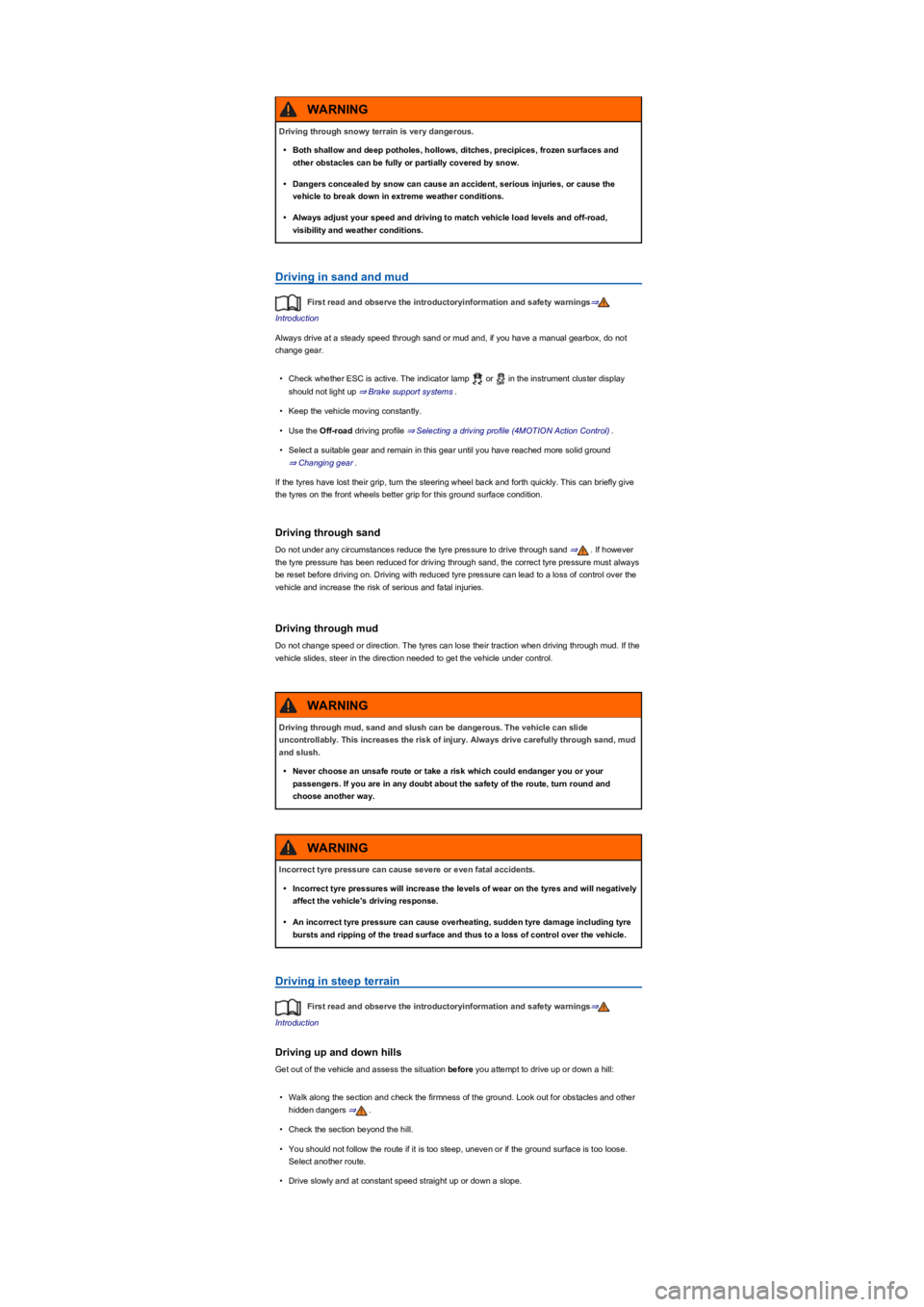
Driving in sand and mud
First read and observe the introductoryinformation and safety warnings⇒
Introduction
Always drive at a steady speed through sand or mud and, if you have a manual gearbox, do not
change gear.
•Check whether ESC is active. The indicator lamp or in the instrument cluster display
should not light up ⇒ Brake support systems.
•Keep the vehicle moving constantly.
•Use the Off-road driving profile ⇒ Selecting a driving profile (4MOTION Action Controlyf.
•Select a suitable gear and remain in this gear until you have reached more solid ground
⇒ Changing gear.
If the tyres have lost their grip, turn the steering wheel back and forth quickly. This can briefly give
the tyres on the front wheels better grip for this ground surface condition.
Driving through sand
Do not under any circumstances reduce the tyre pressure to drive through sand ⇒. If however
the tyre pressure has been reduced for driving through sand, the correct tyre pressure must always
be reset before driving on. Driving with reduced tyre pressure can lead to a loss of control over the
vehicle and increase the risk of serious and fatal injuries.
Driving through mud
Do not change speed or direction. The tyres can lose their traction when driving through mud. If the
vehicle slides, steer in the direction needed to get the vehicle under control.
Driving in steep terrain
First read and observe the introductoryinformation and safety warnings⇒
Introduction
Driving up and down hills
Get out of the vehicle and assess the situation before you attempt to drive up or down a hill:
•Walk along the section and check the firmness of the ground. Look out for obstacles and other
hidden dangers ⇒.
•Check the section beyond the hill.
•You should not follow the route if it is too steep, uneven or if the ground surface is too loose.
Select another route.
•Drive slowly and at constant speed straight up or down a slope.
Driving through snowy terrain is very dangerous.
•Both shallow and deep potholes, hollows, ditches, precipices, frozen surfaces and
other obstacles can be fully or partially covered by snow.
•Dangers concealed by snow can cause an accident, serious injuries, or cause the
vehicle to break down in extreme weather conditions.
•Always adjust your speed and driving to match vehicle load levels and off-road,
visibility and weather conditions.
WARNING
Driving through mud, sand and slush can be dangerous. The vehicle can slide
uncontrollably. This increases the risk of injury. Always drive carefully through sand, mud
and slush.
•Never choose an unsafe route or take a risk which could endanger you or your
passengers. If you are in any doubt about the safety of the route, turn round and
choose another way.
WARNING
Incorrect tyre pressure can cause severe or even fatal accidents.
•Incorrect tyre pressures will increase the levels of wear on the tyres and will negatively
affect the vehicle's driving response.
•An incorrect tyre pressure can cause overheating, sudden tyre damage including tyre
bursts and ripping of the tread surface and thus to a loss of control over the vehicle.
WARNING
Page 165 of 341
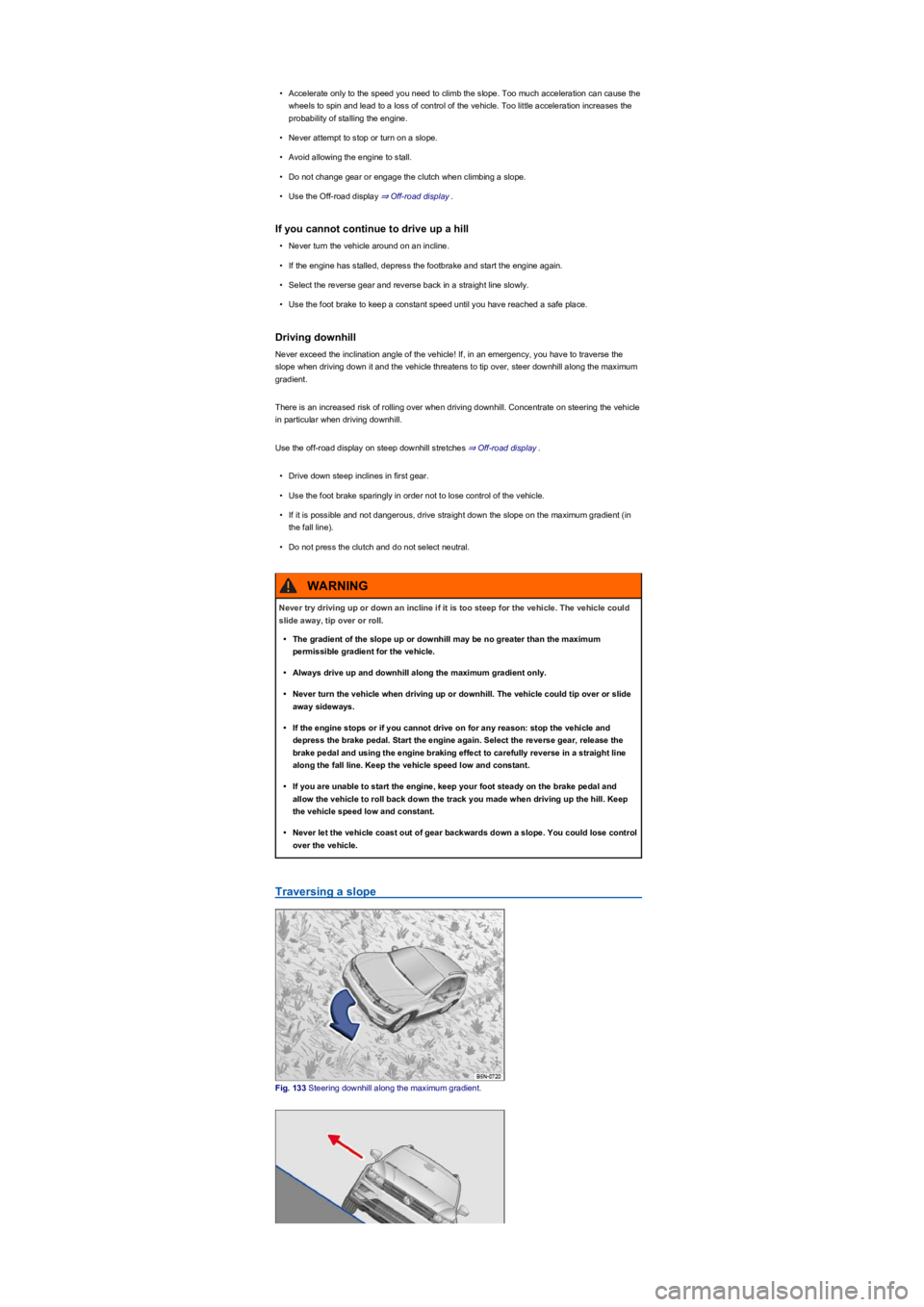
•Accelerate only to the speed you need to climb the slope. Too much acceleration can cause the
wheels to spin and lead to a loss of control of the vehicle. Too little acceleration increases the
probability of stalling the engine.
•Never attempt to stop or turn on a slope.
•Avoid allowing the engine to stall.
•Do not change gear or engage the clutch when climbing a slope.
•Use the Off-road display ⇒ Off-road display.
If you cannot continue to drive up a hill
•Never turn the vehicle around on an incline.
•If the engine has stalled, depress the footbrake and start the engine again.
•Select the reverse gear and reverse back in a straight line slowly.
•Use the foot brake to keep a constant speed until you have reached a safe place.
Driving downhill
Never exceed the inclination angle of the vehicle! If, in an emergency, you have to traverse the
slope when driving down it and the vehicle threatens to tip over, steer downhill along the maximum
gradient.
There is an increased risk of rolling over when driving downhill. Concentrate on steering the vehicle
in particular when driving downhill.
Use the off-road display on steep downhill stretches ⇒ Off-road display.
•Drive down steep inclines in first gear.
•Use the foot brake sparingly in order not to lose control of the vehicle.
•If it is possible and not dangerous, drive straight down the slope on the maximum gradient (in
the fall lineyf�.
•Do not press the clutch and do not select neutral.
Traversing a slope
Fig. 133 Steering downhill along the maximum gradient.
Never try driving up or down an incline if it is too steep for the vehicle. The vehicle could
slide away, tip over or roll.
•The gradient of the slope up or downhill may be no greater than the maximum
permissible gradient for the vehicle.
•Always drive up and downhill along the maximum gradient only.
•Never turn the vehicle when driving up or downhill. The vehicle could tip over or slide
away sideways.
•If the engine stops or if you cannot drive on for any reason: stop the vehicle and
depress the brake pedal. Start the engine again. Select the reverse gear, release the
brake pedal and using the engine braking effect to carefully reverse in a straight line
along the fall line. Keep the vehicle speed low and constant.
•If you are unable to start the engine, keep your foot steady on the brake pedal and
allow the vehicle to roll back down the track you made when driving up the hill. Keep
the vehicle speed low and constant.
•Never let the vehicle coast out of gear backwards down a slope. You could lose control
over the vehicle.
WARNING
Page 168 of 341
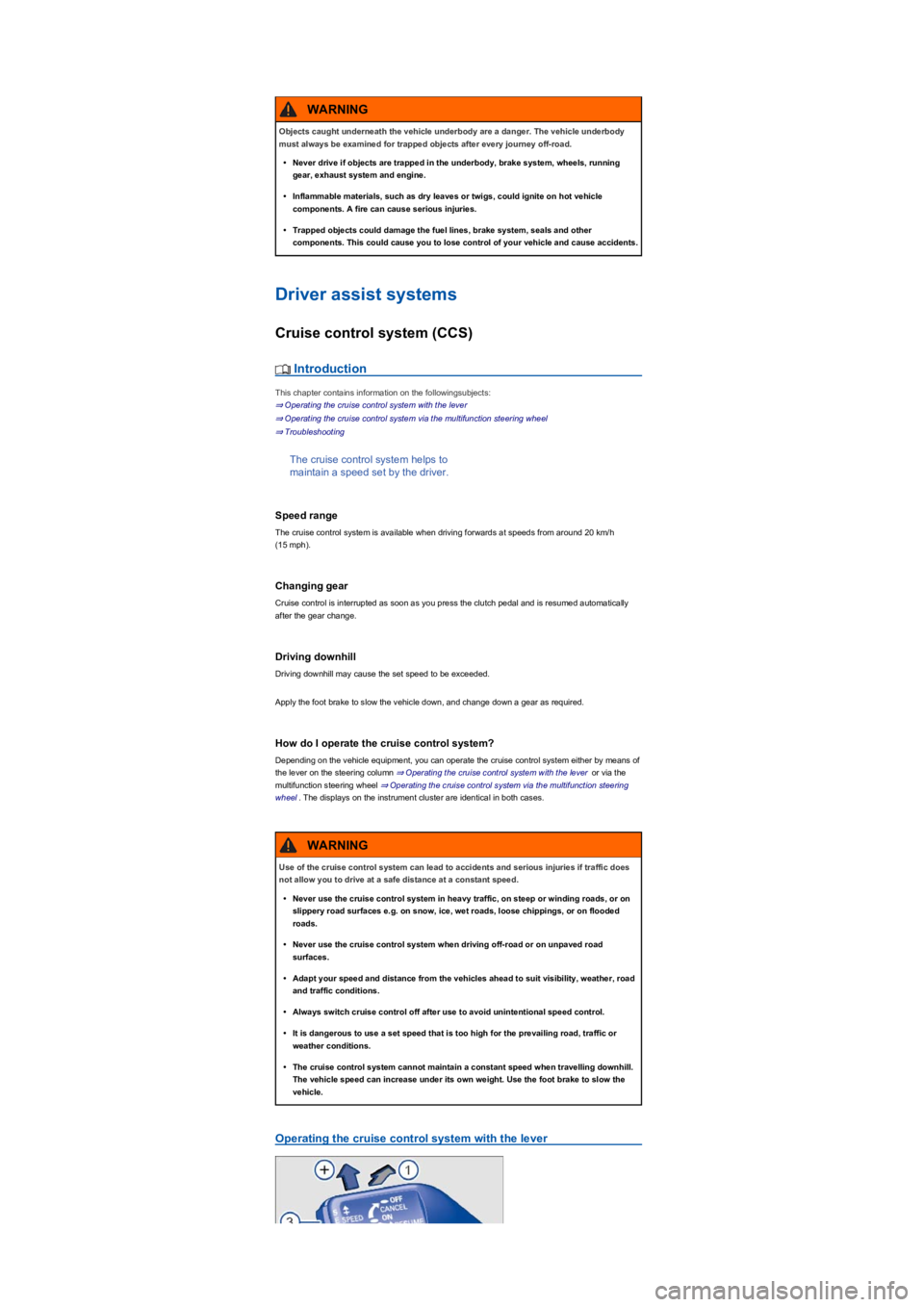
Driver assist systems
Cruise control system (CCSyf
Introduction
This chapter contains information on the followingsubjects:
⇒ Operating the cruise control system with the lever
⇒ Operating the cruise control system via the multifunction steering wheel
⇒ Troubleshooting
The cruise control system helps to
maintain a speed set by the driver.
Speed range
The cruise control system is available when driving forwards at speeds from around 20 km/h
(15 mphyf�.
Changing gear
Cruise control is interrupted as soon as you press the clutch pedal and is resumed automatically
after the gear change.
Driving downhill
Driving downhill may cause the set speed to be exceeded.
Apply the foot brake to slow the vehicle down, and change down a gear as required.
How do I operate the cruise control system?
Depending on the vehicle equipment, you can operate the cruise control system either by means of
the lever on the steering column ⇒ Operating the cruise control system with the lever or via the
multifunction steering wheel ⇒ Operating the cruise control system via the multifunction steering
wheel. The displays on the instrument cluster are identical in both cases.
Operating the cruise control system with the lever
Objects caught underneath the vehicle underbody are a danger. The vehicle underbody
must always be examined for trapped objects after every journey off-road.
•Never drive if objects are trapped in the underbody, brake system, wheels, running
gear, exhaust system and engine.
•Inflammable materials, such as dry leaves or twigs, could ignite on hot vehicle
components. A fire can cause serious injuries.
•Trapped objects could damage the fuel lines, brake system, seals and other
components. This could cause you to lose control of your vehicle and cause accidents.
WARNING
Use of the cruise control system can lead to accidents and serious injuries if traffic does
not allow you to drive at a safe distance at a constant speed.
•Never use the cruise control system in heavy traffic, on steep or winding roads, or on
slippery road surfaces e.g. on snow, ice, wet roads, loose chippings, or on flooded
roads.
•Never use the cruise control system when driving off-road or on unpaved road
surfaces.
•Adapt your speed and distance from the vehicles ahead to suit visibility, weather, road
and traffic conditions.
•Always switch cruise control off after use to avoid unintentional speed control.
•It is dangerous to use a set speed that is too high for the prevailing road, traffic or
weather conditions.
•The cruise control system cannot maintain a constant speed when travelling downhill.
The vehicle speed can increase under its own weight. Use the foot brake to slow the
vehicle.
WARNING
Page 170 of 341
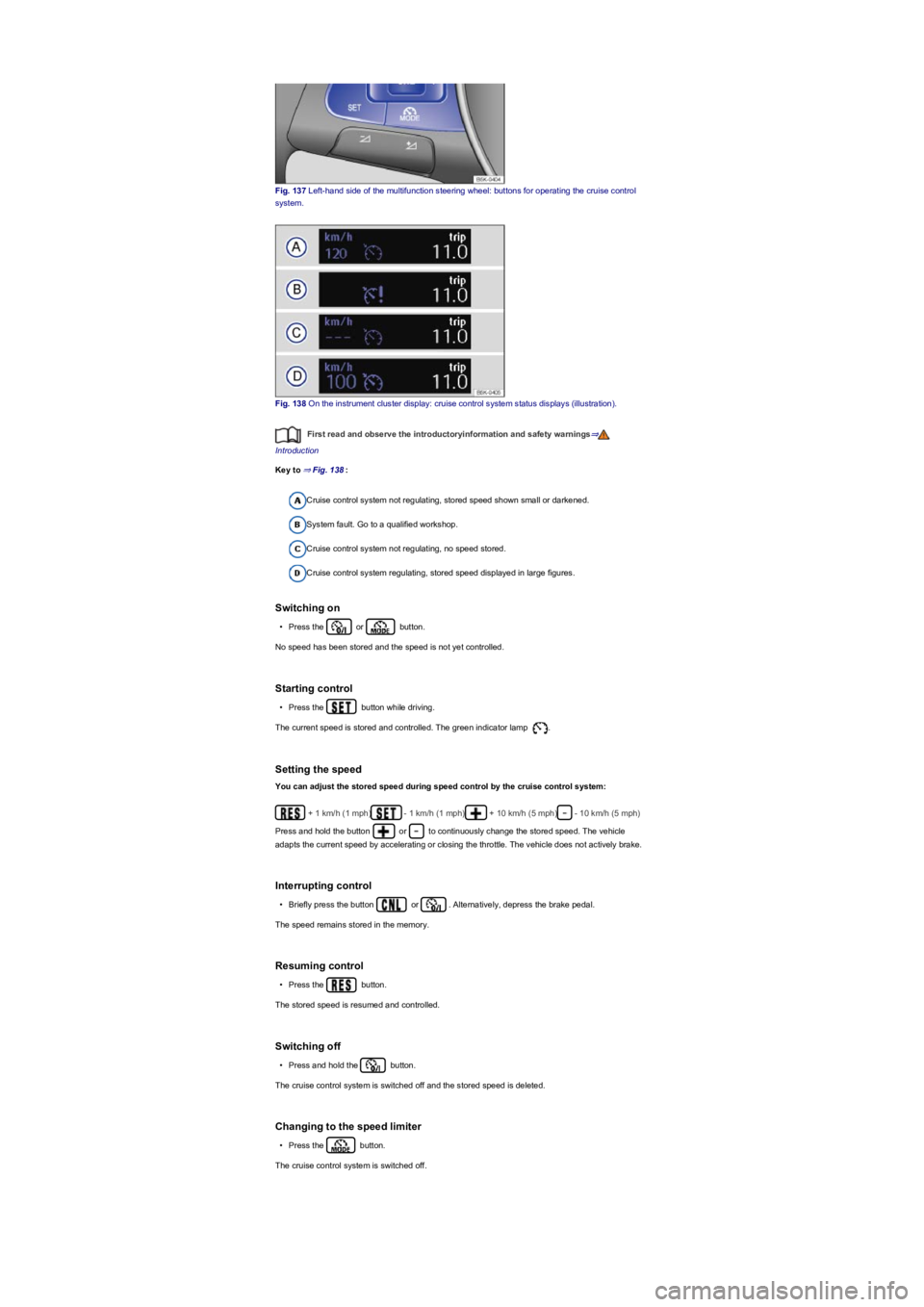
Fig. 137 Left-hand side of the multifunction steering wheel: buttons for operating the cruise control
system.
Fig. 138 On the instrument cluster display: cruise control system status displays (illustrationyf�.
First read and observe the introductoryinformation and safety warnings⇒
Introduction
Key to ⇒ Fig. 138:
Cruise control system not regulating, stored speed shown small or darkened.
System fault. Go to a qualified workshop.
Cruise control system not regulating, no speed stored.
Cruise control system regulating, stored speed displayed in large figures.
Switching on
•Press the or button.
No speed has been stored and the speed is not yet controlled.
Starting control
•Press the button while driving.
The current speed is stored and controlled. The green indicator lamp .
Setting the speed
You can adjust the stored speed during speed control by the cruise control system:
+ 1 km/h (1 mphyf- 1 km/h (1 mphyf+ 10 km/h (5 mphyf- 10 km/h (5 mphyf
Press and hold the button or to continuously change the stored speed. The vehicle
adapts the current speed by accelerating or closing the throttle. The vehicle does not actively brake.
Interrupting control
•Briefly press the button or . Alternatively, depress the brake pedal.
The speed remains stored in the memory.
Resuming control
•Press the button.
The stored speed is resumed and controlled.
Switching off
•Press and hold the button.
The cruise control system is switched off and the stored speed is deleted.
Changing to the speed limiter
•Press the button.
The cruise control system is switched off.
Page 171 of 341
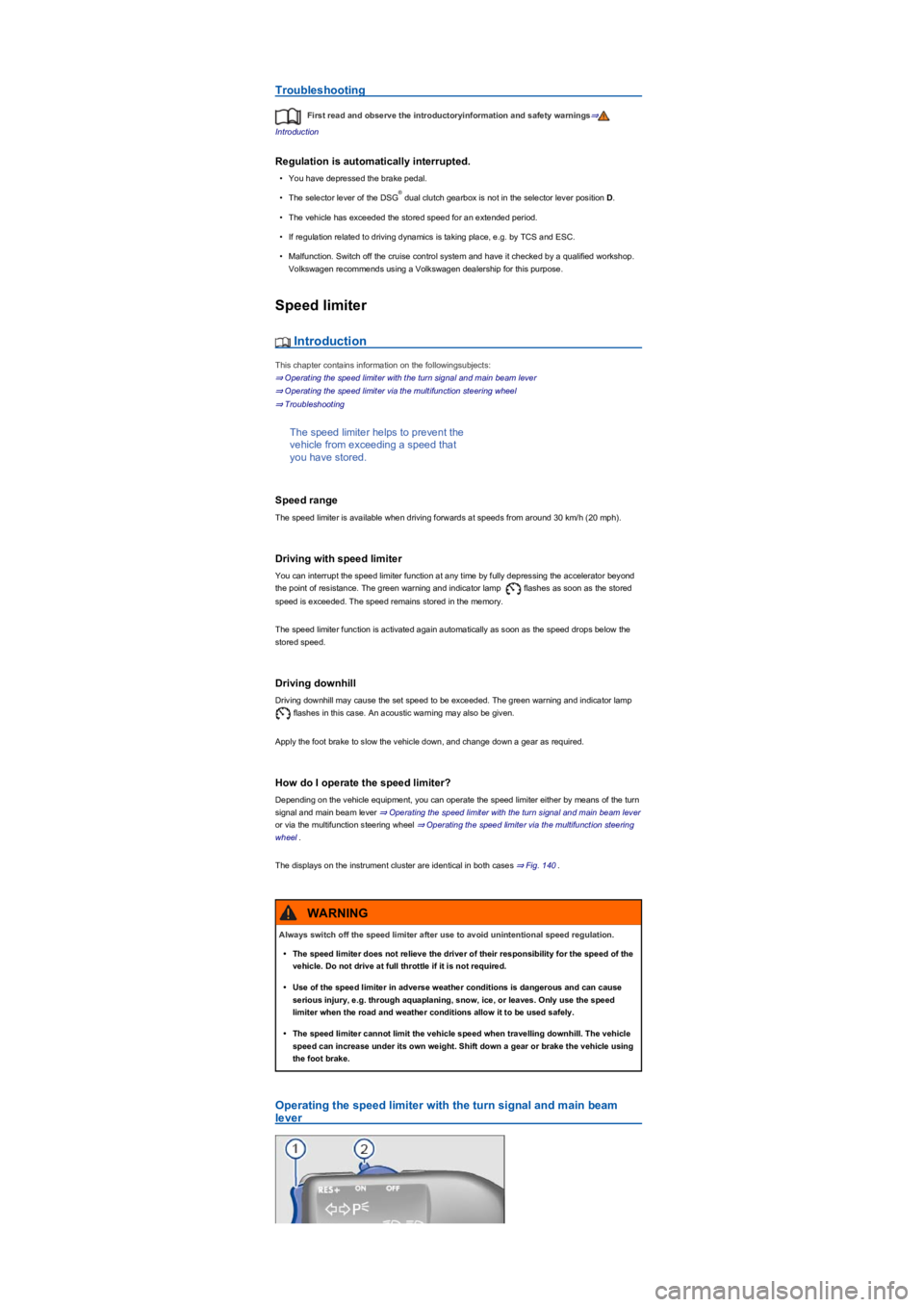
Troubleshooting
First read and observe the introductoryinformation and safety warnings⇒
Introduction
Regulation is automatically interrupted.
•You have depressed the brake pedal.
•The selector lever of the DSG dual clutch gearbox is not in the selector lever position D.
•The vehicle has exceeded the stored speed for an extended period.
•If regulation related to driving dynamics is taking place, e.g. by TCS and ESC.
•Malfunction. Switch off the cruise control system and have it checked by a qualified workshop.
Volkswagen recommends using a Volkswagen dealership for this purpose.
Speed limiter
Introduction
This chapter contains information on the followingsubjects:
⇒ Operating the speed limiter with the turn signal and main beam lever
⇒ Operating the speed limiter via the multifunction steering wheel
⇒ Troubleshooting
The speed limiter helps to prevent the
vehicle from exceeding a speed that
you have stored.
Speed range
The speed limiter is available when driving forwards at speeds from around 30 km/h (20 mphyf�.
Driving with speed limiter
You can interrupt the speed limiter function at any time by fully depressing the accelerator beyond
the point of resistance. The green warning and indicator lamp flashes as soon as the stored
speed is exceeded. The speed remains stored in the memory.
The speed limiter function is activated again automatically as soon as the speed drops below the
stored speed.
Driving downhill
Driving downhill may cause the set speed to be exceeded. The green warning and indicator lamp
flashes in this case. An acoustic warning may also be given.
Apply the foot brake to slow the vehicle down, and change down a gear as required.
How do I operate the speed limiter?
Depending on the vehicle equipment, you can operate the speed limiter either by means of the turn
signal and main beam lever ⇒ Operating the speed limiter with the turn signal and main beam lever
or via the multifunction steering wheel ⇒ Operating the speed limiter via the multifunction steering
wheel.
The displays on the instrument cluster are identical in both cases ⇒ Fig. 140.
Operating the speed limiter with the turn signal and main beam
lever
®
Always switch off the speed limiter after use to avoid unintentional speed regulation.
•The speed limiter does not relieve the driver of their responsibility for the speed of the
vehicle. Do not drive at full throttle if it is not required.
•Use of the speed limiter in adverse weather conditions is dangerous and can cause
serious injury, e.g. through aquaplaning, snow, ice, or leaves. Only use the speed
limiter when the road and weather conditions allow it to be used safely.
•The speed limiter cannot limit the vehicle speed when travelling downhill. The vehicle
speed can increase under its own weight. Shift down a gear or brake the vehicle using
the foot brake.
WARNING